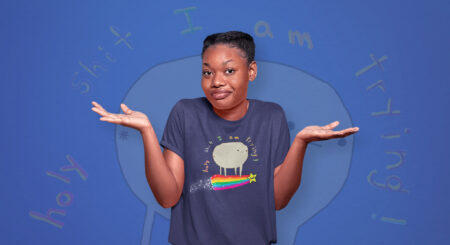And I’m back.
It’s time for me to finish up my two-part series on fictional worlds I want to see adapted into films. If you missed the first part of the series and need to catch up, you can read it here.
Since I know everyone has stuff they “actually should be doing”, and that many of you are being super-polite and patient and waiting until I’m finished with this post to tell me what you think about my choices (and how very, very wrong I am), let’s just get to it, shall we? As to the people holding their tongues, I commend you all for your willpower. To everyone else, thanks for blowing stuff off for me!

Saga (2012-present) by Brian K. Vaughan & Fiona Staples
 If you follow comics and you haven’t heard about Saga yet, I’m impressed. It seems to be the comic everyone is talking about (and already saying is unfilmable). The series has won five Eisner Awards, and it’s been nominated for three more. Threadless Warehouse Director and Comic Book Czar, Lance Curran, even mentioned it in his Top 5 Comics to Read Immediately post.
If you follow comics and you haven’t heard about Saga yet, I’m impressed. It seems to be the comic everyone is talking about (and already saying is unfilmable). The series has won five Eisner Awards, and it’s been nominated for three more. Threadless Warehouse Director and Comic Book Czar, Lance Curran, even mentioned it in his Top 5 Comics to Read Immediately post.
Being a lukewarm fan of Y the Last Man, I picked up Saga a couple years ago with skepticism. That 30% of me that was optimistic about it deserves one big cookie from my cynical side, because oh my bloody happiness, is this comic just a delicious universe of imaginative awesomeness!
It is a sci-fi dystopian star-crossed love story, filled with cross-sectioned ghost babysitters, robot prince sexual perverts, spider bounty hunters, and cyclops authors that write books that look like trashy romance novels but actually contain complex philosophical beliefs. For me, it melds three big loves: space story lines, mythology, and horror. Not to mention, the female-centric, feminist qualities of the comic that make it feel fresh and exciting.

The story begins with Alana giving birth to her and Marko’s daughter, Hazel, who is the narrator of the story. Alana and Marko are from two different extraterrestrial races at war with each other. They are both grunts in the military and meet when Marko is a POW under Alana’s care. When it is discovered that they have run off together, gotten married, and had a baby, the people in charge of both nations want them captured, because they don’t want the symbol of their love to affect how the population views the war. Bounty hunters are hired, Prince Robot IV is sent out in pursuit, Marko’s ex-fiance comes after them, and Alana and Marko flee with Hazel (in a tree spaceship) and go into hiding. It is a story about love, hope, family, and connection.

Fiona Staples’ artwork is clean and lush and colorful. And whatever I occasionally can criticize about Brian K Vaughan’s writing, I happily forgive again and again, because he is creating one of the most unique universes that anyone has in, well, damn forever. Additionally, the renderings of early parenthood and love are so touching that, at times, it’s visceral.

Even though Saga is the newest fictional world on this list and is still being written (only the fifth collected volume is slated to be released in September), I see no reason on waiting to say that I would absolutely love seeing it made into a movie.

It would be a fun and thrilling movie, but mostly, a moving and beautiful one about the seemingly small moments that change us forever.
My Director Pick: Guillermo del Toro

Vaughan stated in an interview with Comic Book Resources that he isn’t interested yet in adapting Saga to film or television, because it doesn’t appear that “the technology or financial model exists yet to realistically make Saga work.” However, he would be particularly interested in “being proven wrong” if Paul Thomas Anderson wanted to direct. Well, sorry Vaughan. I don’t think P. T. Anderson is the right director for you; Warren Ellis got him. Please don’t be sad though. You are getting Guillermo del Toro.

I remember the first time I saw Pan’s Labyrinth; it was on a Sunday afternoon during one of the best movie-watching weekends of my life (I went to see Children of Men, Alfonso Cuarón’s brilliant dystopian film the night before). I was swept up in the mythos of the film and the juxtaposition of realism and fantasy. It was haunting to experience the aftermath of the Spanish Civil War through the eyes of a young girl trying to understand its implications. Pan’s Labyrinth is the greatest love letter to horror and why we need it that I have ever seen. And it is similar to Saga in that it focuses on how people struggle and survive within larger societal problems that are not of their making.

Other than horror and mythology, Guillermo del Toro’s major films of the last decade (sorry to the Blade II fans who were hoping I would squeeze it in; it missed my time frame for conciseness cut-off) all share one big theme: connection. In Pan’s Labyrinth, it is about connecting to the world by re-imagining it through stories. The Hellboy movies are about connecting to others through friendship when we feel isolated and alone. In Pacific Rim, Guillermo is even more literal about the theme of connection and why it is vital. In order to run a Jaeger, robots designed to fight Kaiju, the pilots have to connect their minds and lock them in a neural bridge called The Drift. If we want to save the world, we need to first connect with others.

Even though Saga is a sweeping epic space opera, which Vaughan has said was influenced by Star Wars, it is primarily a story about the small instances of connection and love that drive our decisions. To be able to pull the movie off properly, a director would have to take seriously the earnestness in Vaughan and Staples’ universe while not letting themselves get carried away with the action and special effects of the film.

Guillermo would be able to handle this issue deftly. The most touching and unnerving moment in Pacific Rim is the flashback sequence where Mako Mori is caught within her memory of being alone as a young child, hiding from a Kaiju attack. The sequence is emotional and big and never ceases to put Mako’s fear at center stage in spite of being surrounded by a massive amount of special effects. Saga is full of moments like these; it needs a director that can handle them. That is what Guillermo does. He uses epic worlds as a backdrop to tell intimate stories in order to show how those stories are the most vital and important.

Guillermo has proven time and again he can make big epic movies; he has also shown that he is wonderful at adaptation. A great example of this is the Hellboy movies, particularly the first one. Guillermo takes Mike Mignola’s minimalist, moody, and surreal comic, trusses out the humor and themes of connection, and manages to create a film reminiscent of the comic’s darkness that nods to mythology while still being completely his own interpretation.

If none of that convinces you, Guillermo is the ultimate fanboy. He famously bought a second house to store his collectibles and comic book collection. One of my favorite moments in the documentary, Comic Con Episode IV: A Fan’s Hope, is when Guillermo talks about out-bidding Mike Mignola on Ebay for comics drawn by an obscure artist they both collect. I believe that he would be conscientious of treating the Saga universe with respect. Lastly, he has the clout to create a new “financial model” for Saga. He spent over five years fighting Columbia Pictures to get Ron Perlman to play Hellboy.

So, to Guillermo: I adore you. I probably don’t need to ask you to direct Saga, because you have likely already read it and are currently trying to finagle a way to adapt it and fit it into your busy schedule. Break a leg, because I’m rooting for you.
We (1921) by Yevgeny Zamyatin
 Yevgeny Zamayatin’s 1921 novel, We, is generally considered to have started it all (the modern dystopian narrative), proving, yet again, that Russian writers do it better. George Orwell read it and soon wrote 1984. And even though Aldous Huxley said it didn’t influence him, there are, like with 1984, many similarities between Brave New World and We.
Yevgeny Zamayatin’s 1921 novel, We, is generally considered to have started it all (the modern dystopian narrative), proving, yet again, that Russian writers do it better. George Orwell read it and soon wrote 1984. And even though Aldous Huxley said it didn’t influence him, there are, like with 1984, many similarities between Brave New World and We.
We is set in a dystopian society far, far into the future. There is no specific time relation to present day (it’s all murky), but we know that the events of the novel begin 1000 years after the Two Hundred Year war, where the One State won and conquered the world. The Benefactor runs the city and the Bureau of Guardians or “secret police” enforces compliance. The novel is written as a journal by the main character, D-503, that he begins so it can be included in a spaceship planned to be sent into outer space to contact aliens.
The city is closed off from the natural world by a giant, green wall. Everyone lives in apartments and all buildings (except the Benefactors and Guardian’s, obviously) are made of glass so that all the inhabitants can always be watched. There is no privacy, no autonomy, and individuality is considered negatively.

Zamaytin creates a clean, sterile, streamlined universe in his novel. The streets are clean. The machines are clean. There is nothing inessential in this society, not even unique names. He is the minimalist modernist of the writers included on this list. If We were a house, it would not have one knick-knack on a shelf or one superfluous throw pillow.
I can see the sunlight, beautiful and terrifying, always there and inescapable, on D-503’s face as he stands in his apartment.

Amazingly, this book has never been adapted to film, at least not in the United States. A German television show recreated it once. I think it’s because, like 1984, which is only recently getting redone and spun as a love story (which isn’t off-the-mark), We is an action-less movie. It’s about internal dilemmas, the concepts of individuality and conformity, and the silent pain of living without any real connection. Basically, there aren’t any car chase scenes.
Even so, you’d think the granddaddy of modern dystopia would have been made into even a bad movie at this point. Well, lucky for me and my post, it hasn’t. There’s always a silver lining, kids.
My Director Pick: Terrence Malick

In a rare interview, discussing Italian movies that he loves, Terrence Malick peripherally discussed one of his own films. Agreeing that he uses nature in The Thin Red Line in a similar way that Federico Fellini does in a particular scene from The White Sheik, Malick says about Fellini’s film, “It adds even more innocence to the scene and effectively symbolizes the purity of the girl and of her perception of the world, which has not been tarnished yet.” The writer of the article about this interview points out that “innocence” and “purity” and losing them is the concept Malick appears to be extremely interested in watching.

It also happens to be the theme he is obsessed with playing out in his own films. This obsession makes him a perfect match for We, because D-503’s journey, although an awakening, is also a loss of innocence. Throughout the course of the novel, D-503 must come to accept that the ideals he has been indoctrinated with are wrong.
In The New World, Pocahontas falls in love and she believes that love is stronger than cultural and spatial differences. She awakens to the reality that it isn’t, and we watch her renegotiate her beliefs. Malick handles this transformation subtly and kindly, allowing Pocahontas to gain strength through her loss of innocence and pain. D-503 deserves the same kind of treatment, and I can’t think of another director who can handle the complexity of losing faith like Malick.

To the Wonder is about a couple that have an intense connection, fall in love, transform their lives for each other, and then spend the following years of the film attempting to recreate the childlike passion they first experienced when they met. It also follows a priest, who is questioning his faith in God. The two stories work side-by-side to show how isolating life is without love as well as how the pursuit of love can make us myopic. A large part of any dystopian narrative deals with disconnection. In contrast to Guillermo del Toro, Malick’s films deal with the lack of connection and our struggle to attain it, many times finding it is just out of reach.

Some of the best sequences in The Tree of Life are the ones of Sean Penn’s character attempting to function at his job in spite of not being engaged by it. Malick captures the experience of being mentally disassociated from your physical surroundings completely. These are the kind of moments that need to happen in We. I think one of the primary reasons dystopian stories, like We, are so popular is not because people especially fear a police state, but instead, because so many of us connect to the type of loneliness that occurs when what society expects of us and who we actually are is at odds with each other.

Ultimately, as stated above, We is about internal dilemmas—about the soul screaming inwardly while a person appears to feel nothing outwardly. It is that dramatic and calm all at once. That’s what Malick does. He takes us inside the minds of strangers and let’s us experience Sonder, “the realization that each random passerby is living a life as vivid and complex as your own.” He makes us ache for ourselves, for the world, and everything we lose as we gain knowledge.

To Terrence Malick: Even though I know you will find some way to fit a beach sequence into the film (because there always is a beach sequence in your films), I still want you to direct We. I appreciate that you like writing your own scripts, so I am giving you permission to rearrange and modify the hell out of We. Because however you rearrange it, the end result will be something new and beautiful and make us feel D-503’s journey.

So there you are, I have done the obnoxious fangirl thing. I have taken two things I love, mashed them together, and convinced myself that I am absolutely correct about my choices. Because I am a genius.
My choices aside, I have to say that I need new worlds. I’m tired of all these superhero movies; the worlds are getting so dull. Superhero worlds are just our world but with people that can fly or read minds or punch a hole in cement buildings, making them crash to the ground.
I remember, years ago, my grandfather gave me copies of the first three Harry Potter books. He, who never read anything after Hemingway, was finishing the fourth book in the series. I read all four books in roughly five days. I was captivated, and I don’t think I’m alone in saying that as a fan of the Harry Potter series, the plotline (not especially unique) is secondary to the imaginativeness of the world all the action is set in. Or as my grandfather said to me when he gave me the books, “This J. K. Rowling understands what we need.”

And she did. We need fantasy. We need the unreal and the awesome. We need the world refracted back to us in brighter or bleaker images. So another movie about Captain America saving the world (regardless of how hot Chris Evans is) just won’t do.
I think the critical and commercial success of Fury Road proves that I’m right.




